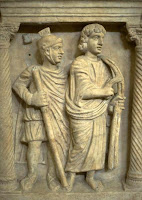During the reign of Herod there was increasing pressure from the Roman government for Jews to conform to Roman culture while Jews sought ways to maintain their own identity. Some Jews advocated rebellion against the Roman authorities. According to the gospels Jesus and his followers pressed for Jews to reform their practices and atone for their sins. Jews developed their arguments on both sides of the debate, but in all cases their arguments were described as within the context of Judaism. The gospels describe growing opposition to Jesus from the Romans and some Jewish religious leaders who did not accept Jesus’ interpretation of Jewish law. Jesus is described as being arrested in Jerusalem, tried and condemned to the common Roman method of executing rebels, crucifixion. His execution took place under the rule of Pontius Pilate , Roman Governor of Judea from 26-36 C.E. According to Paul and the gospels, God raised Jesus from the dead.

Arch of Titus in Rome. This detail depicts the destruction of the second Beit HaMikdash (Temple) in 70 (C.E.), Common Era; Judaism divides into Rabbinic (mostly Palestinian) and Messianic (mostly Diasporic and partly converted "God Fearers") groups.
 Mosaic: Jesus in His Glory about 400 C.E. Santa Pudernziana, Rome. In traditional Judaism a messiah is a Jew inspired by God to lead his people in times of need. The Roman Period saw a pagan power ruling the acred Land of Israel. It was a period of unrest and revolt and the Romans crucified thousands of insurectionists, several of whom either self-proclaimed or were considered by their followers to have been sent by God to eject the pagans from their holy land.
Mosaic: Jesus in His Glory about 400 C.E. Santa Pudernziana, Rome. In traditional Judaism a messiah is a Jew inspired by God to lead his people in times of need. The Roman Period saw a pagan power ruling the acred Land of Israel. It was a period of unrest and revolt and the Romans crucified thousands of insurectionists, several of whom either self-proclaimed or were considered by their followers to have been sent by God to eject the pagans from their holy land.
 Judgment of Pilate, detail of 5th [far R.] panel, mid-4th Century C.E. (probably from the Catacomb of Domitilla). Of interest here is that Pilate, represented as finding Jesus innocent, washes his hands, a Jewish tradion. During the early centuries of the seperation, in defining itself seperate from "Judaism" Christianity as the "New Israel" coopted traditional Jewish customs and rites and denied them to traditional Judaism.
Judgment of Pilate, detail of 5th [far R.] panel, mid-4th Century C.E. (probably from the Catacomb of Domitilla). Of interest here is that Pilate, represented as finding Jesus innocent, washes his hands, a Jewish tradion. During the early centuries of the seperation, in defining itself seperate from "Judaism" Christianity as the "New Israel" coopted traditional Jewish customs and rites and denied them to traditional Judaism. Christ with Roman guard before Pilate, detail of 4th [RC.] panel, mid-4th Century C.E. (probably from the Catacomb of Domitilla) The personage of Jesus emerging from the gospels is an insurectionist, capturing the Temple, the symbol of Israeli independence, and holding it for many days. As such he would have been condemned to death and crucified under Roman law. That Pilate is represented as not responsible is a reversal of historical precedent, and clearly meant to shift blame on to the Jews in an effort to appease Rome.
Christ with Roman guard before Pilate, detail of 4th [RC.] panel, mid-4th Century C.E. (probably from the Catacomb of Domitilla) The personage of Jesus emerging from the gospels is an insurectionist, capturing the Temple, the symbol of Israeli independence, and holding it for many days. As such he would have been condemned to death and crucified under Roman law. That Pilate is represented as not responsible is a reversal of historical precedent, and clearly meant to shift blame on to the Jews in an effort to appease Rome.
 Early 5th Century A.D. British Museum, London. One of four ivory panels from a casket depicting religious themes. One of the earliest known illustrations of the Crucifixion. By shifting blame for the crucifixion onto the Jews, early Christianity laid the foundation for future persecutions in the lands of Jewish dispersion.
Early 5th Century A.D. British Museum, London. One of four ivory panels from a casket depicting religious themes. One of the earliest known illustrations of the Crucifixion. By shifting blame for the crucifixion onto the Jews, early Christianity laid the foundation for future persecutions in the lands of Jewish dispersion.

2 comments:
are these images copyrighted?
Antisemitism, Yes or No? Is it Antisemitic for a Person of Non-Jewish Heritage to Create a Fake “Jewish” Persona/Alter Ego/Mask for Self Promotion & Business Purposes?
Seeking interviewees in reference to antisemitism for a feature documentary. Once you’ve read the below information and description, you’re welcome to make a comment (anonymous is okay) and/or contact us directly at contact@mydogspotproductions.com if you’d like to go on-the-record with your opinion.
http://gogogirldocumentary.blogspot.com/2012/09/anti-semitism-yes-or-no-is-it-anti.html
Post a Comment